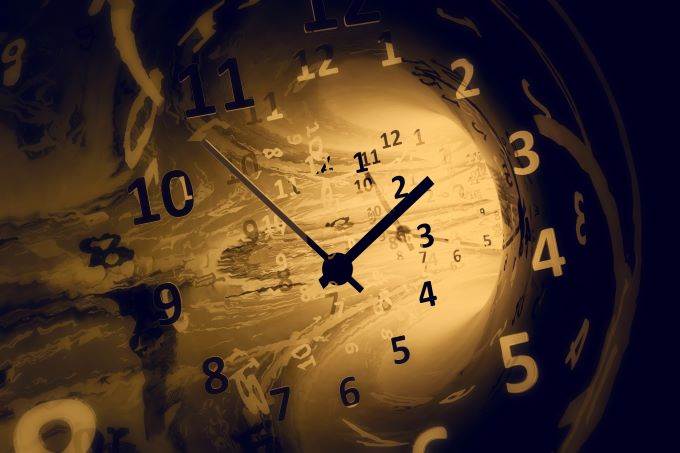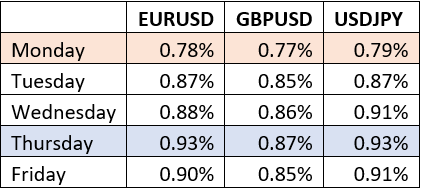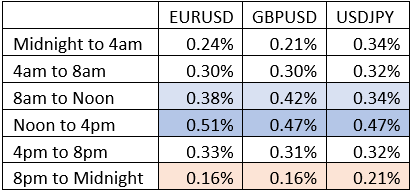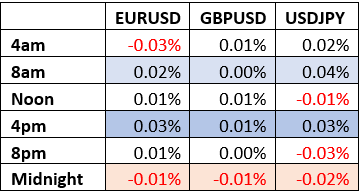Best Time of the Month to Trade Forex
Many traders believe that Forex markets tend to behave differently right at the beginning or end of a calendar month. The logic behind this belief is that large investment institutions often decide to change their investments at these times. If this belief is true, we should expect to see evidence that trend reversals and relatively higher volatility have been more likely to happen at the turns of months.
Top Forex Brokers
We can test this by examining the below table which compares average daily volatility on the first calendar day of a new month and on the 15th of each month for the major Forex currency pairs:

The historical evidence shows that volatility in the major Forex pairs has tended to be no higher right at the start or end of a calendar month than it has been at other times of the month.
What about trend reversals? Is there any evidence that trends have been more likely to reverse at the turns of calendar months? We can test this by seeing whether 50-day breakouts were less likely to be successful when they happen at the start of a new month, compared to their success over all days, by measuring the next day’s averaged price movement:

Overall, trend breakouts at the start of a new calendar month seem to have had a higher probability of failing than breakouts which happen at other times.

Trend traders should be aware that for them, the very start or end of a calendar month HAS NOT historically been the best time of the month to enter a new trade, as the price has an unusually high tendency to reverse its trend.
Range traders should be aware that for them, the very start or end of a calendar month HAS BEEN a good time of the month to enter a new trade, for the same reason.
Best Day of the Week to Trade Forex
The retail Forex market is open continuously from Monday morning in New Zealand until Friday evening in New York. This means that in the U.K., which we use as a time benchmark as it is in the UTC / GMT time zone, most Forex brokers open on Sunday evening and close relatively early on Friday evening, but are open for trading throughout all that time, although some brokers shut for a few minutes at the New York closing time every day to calculate rollovers. So, what time does Forex open on Sunday in the U.K.? The answer is 10pm, and it closes at 10pm on Friday night too, except for the couple of weeks each year when the U.S. and U.K. are out of sync in moving clocks backwards or forwards – during this time it may vary from 10pm by an hour.
The day of the week can be an important factor in trading Forex, but its importance will vary depending upon whether you are a day trader or a longer-term swing or position trader.
Day traders do not leave trades open over a weekend when markets are closed, so do not have to worry about risks associated with doing that.
Longer-term traders should be aware that there are important risks involved in leaving trades open over the weekend, as stop losses can be exceeded if the market opens at the start of the next week with a price gap beyond the stop loss. This means you can lose much more than you planned to in a worst-case scenario. You cannot exit Forex trades over the weekend, although there are a few rare cases of brokers providing weekend trading facilities to their clients.
If you are a long-term trader hoping to make a winning trade that runs over a few days, consider that the earlier in the week you enter a trade, the better chance you have to exit the trade with a profit before the weekend arrives with its extra risks of leaving a trade open.
It is widely believed that the Forex market usually begins the week quietly, then tends to increase in volatility as the week progresses towards the weekend. Historical data shows this is broadly true. The chart below shows the average price movement by day of the week for the major Forex currency pairs:

If you are a day trader, it makes sense to aim to trade during the most volatile periods. This means that Monday might be a good day to not be in the market, while Thursday is a day not to miss.We can see that for all of the three majors, Monday tended to be the quietest day, while the day with the largest average price movement was Thursday.
If you are a swing or position trader, it makes sense based on the data to try to enter new trades earlier in the week, and then to hopefully benefit from the higher volatility later in the week before maybe exiting the trade before the weekend. However, there are other factors to consider depending upon whether you are hoping to profit from trend trading or range trading, considered in more detail at the end of this section.
The issues explored here about day of the week in Forex trading are well-known and there are logical reasons for the differences shown here. The Forex market is often moved by major economic announcements by governments and central banks, especially those concerning the U.S. Dollar. These data releases tend to be scheduled towards the end of the working week, with nothing usually scheduled on Mondays.
Another factor is the Forex convention of charging triple swap at Wednesday’s New York close. This means it is cheaper to trade after that day has passed, i.e. on Thursday or Friday, and this helps to increase volatility near the end of the week.
Finally, be aware that if you are trading on a public holiday in the country whose currency you are trading, or in the U.K. or the U.S.A., volatility in a Forex currency pair is likely to be abnormally low.
Best Day of the Week for Swing / Position Traders
I mentioned earlier that there is an advantage for longer-term traders in entering new trades as early in the week as possible. There are additional factors to consider depending upon whether your strategy is trading trends or trading ranges.
It is widely believed that the Forex market usually begins the week indecisively, changing direction over Monday and Tuesday before starting to trend more decisively from Wednesday to Friday. The chart below shows how 50-day breakouts performed over the next day by day of the week entered for the major Forex currency pairs:

We see that there is some truth to the belief that the best entries for longer-term trend traders have tended to occur on Wednesday and Thursday. Longer-term traders looking to trade range trading strategies have been likely to be most successful when entering trades towards the end of Friday and on Monday.
Best Time of the Day to Trade Forex
Whether you are a day trader or longer-term position trader, it will be useful to you to know whether there has historically been any extra advantage in entering trades at a special time of the day. This will be most useful to day traders, who need to trade intensively and must therefore make very effective use of their time.
It is obvious that a currency usually fluctuates the most in value during the business hours of its country, due to international trade. By this logic, if you live in Asia and you want to trade during your daytime, for example, you will see the most price movement by trading Asian currency crosses such as the AUD/JPY.
This is complicated a bit by the fact that the global Forex market is dominated by the trades made in London and New York, where higher volumes of currency exchanges are conducted than anywhere else. Therefore, the most Forex price movement you are likely to see overall is during business hours in London and New York, with the peak time being the few hours when both centers are open simultaneously.
The best way to prove this is to compare average price movement by the major Forex currency pairs over the eight four-hour periods that make up the day, by London time:

The greatest average price movement in all the major Forex currency pairs has happened from Noon to 4pm London time, which includes the London/New York overlap. The hours from 8am to Noon have been the second most active, representing the first few hours of the London business day. The hours at the end of the day around the New York close, before Tokyo opens, have shown the lowest average price movement.
If you are a day trader looking to benefit from trading the most volatile times of day, you are likely to do best by focusing on the active hours. This may be difficult if you live in a time zone far from UTC and you do not want to get up in the middle of the night. In this case, you would be wise to consider either becoming a swing or position trader, or to trade currencies whose countries’ business hours run during the time of day you have available for your trading. For example, if you live in Australia, you might find it most convenient to try to focus on trading AUD/JPY, AUD/USD, and AUD/NZD.
A final issue to consider about time of day: spreads, which represent the cost of trading, tend to be narrowest when the market is most active. For the major Forex currency pairs, this will be the London / New York overlap. Asian currency crosses may see their tightest (cheapest) spreads during the Asian sessions as a rule.
Are Certain Times of Day Better for Trends or Ranges?
This question is important for all types of traders, as if the price tends to trend better or worse at a certain time of day, these might be the best or worst times for trade entries depending upon your trading strategy.
We can answer this question by comparing what happened, on average, in the four hours after a 50-day breakout in any of the three major Forex currency pairs, depending upon which time of day (London time) the breakouts happened:

Bottom Line
From this, we can conclude that traders looking to trade with the trend have had the greatest chance of getting the strongest price movement in their favor right away at about 4pm London time, with 8am a close second. Range traders are likely to do best between 8pm and Midnight.
Paying attention to the time of day, week or month isn’t going to be a winning Forex trading strategy in itself, yet there have been statistical tendencies based around these timings which you can use to improve the edge of a good trading strategy. You might do this by risking a little more when trades set up at the “better” times and a little less at the “worse” times.
The key edges you can apply can be summarized as:
- Be careful entering trend trades right at the end of beginning of a calendar month.
- For day traders, Thursday usually had the most potential, and Monday the least.
- Longer-term trend traders have usually seen the best movements in their favor on Thursdays and Fridays.
- Range traders have usually seen ranges hold most often on Mondays and Tuesday.
- Major Forex currency pairs have shown their greatest price movement between Noon and 4pm London time, representing the overlap between the London and New York trading sessions.
- Major Forex currency pairs have shown their lowest price movement between 8pm and Midnight London time.
- Major Forex currency pairs have shown their greatest propensity to trend between 4pm and 8pm London time. Often, the day’s “direction” is established by 4pm.
- Major Forex currency pairs have shown their greatest propensity to trend between Midnight and 4am London time.
Methodology
The data presented above is derived from publicly available Forex price data released by a major Forex broker. The period of historical data used runs from the second half of 2001 until the second quarter of 2020, covering a period of almost twenty years.
FAQs
What are the best months to trade forex?
The last few months of the calendar year have tended to see the strongest Forex trends, while the months of July and August have tended to produce low volatility and ranging prices.
What is the best Forex pair to trade?
The EUR/USD currency pair usually has the lowest cost of trading, and also has tended to trend more reliably than any other currency pair, albeit slowly.
What is the best time to trade Forex in UK?
The time of both the greatest price movement and strongest trend usually takes place between Noon and 4pm London time. The hours from 8am to Noon are usually the second-best time.
What time do Forex markets open?
Forex markets are open from about 9am Monday in Sydney until 5pm Friday in New York. The retail Forex market runs 24 hours daily during weekdays.The retail Forex market in the U.K. usually opens at 10pm on Sunday nights for the week.
When should you not trade Forex?
You should only trade Forex when you see a good trading opportunity, where you have a good reason to think the odds are in your favor that the price is going to move either up or down by enough to justify a trade. You should never, ever trade just for the sake of trading.
Can I trade Forex at night?
Wherever you are in the world, you can trade Forex at night, because the global Forex market is open continuously from Monday morning in Asia until Friday evening in the U.S.A.
